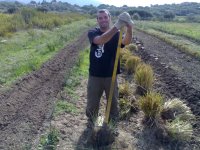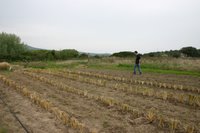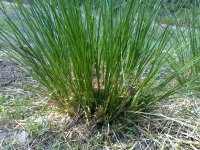
It has been a while since the last time that I recapped the
properties of the vetiver plant and the applications of the
Vetiver System, this goes especially towards those who
tuned on this interesting world, only recently.
One of the distinctive properties of the vetiver plant is
the root system: it is infact of massive proportions and
it developes only vertically; the incredible number of single
roots that developes are extremely fine: the average
thickness of the single root is measurable between 0,2
and 2 mm and the depth that this root system can reach
is up to 5 - 9 m. A good point to this particular type of
root is that it penetrates the soil strata wrapping the
obstacles and filling the gaps not causing any tension
or stresses to the subsoil, thoug not causing any movement
that can result in rock fall or instability of the overall slope.
The depth reached, also, is the main cause of the plant
survival in the dry period; infact humidity is always present
in the deeper strata of the soil.
The verticality of the developement also implies that the
competition for nourishment and moisture is simply not
present and does not regard adjacent crops or native
essences.
The proven sterility of the vetiver (Monto or sunshine var.)
make sure that it can be introduced in any environment
without any risk of genetic pollution.
The physiology of such plant is applied in the Vetiver System
with the aim to bring to stability almost any slope at risk
applying some simple rules: we need to create barriers
so it is important to allign the plants when planting, in
such way to obtain quickly formed hedges.
The plants will have then a density of 7 - 10 plants in the
meter. The hedges will have to be lied on the contour
in such way not to offer to rainwater any possibility of
finding an escape.
The result will be that water will penetrate in the subsoil
along each hedgerow and there will be no more sediment
flowing or erosion to modify the slope.
In a few monts then, when the plants can be considered
fully grown and the hedgerows well formed, we can assume
that the risk of instability is considerably reduced (up to 40%
increase of the shear strenght factor) thanks to the gripping
action of the root system, and above soil, a very efficient trap
eliminates any sediment flow.
The prevention of diffused erosion is furthermore the first
step towards a new type of agriculture, made of ecological
understanding and profit together, that prevents loss of
soil and fertility, pollution of watertable and food chains.
The slope then is transformed: no more only a risk, but
a safe factor that can be used to bring advantages:
the hedgerows infact infiltrate the rainwaters which are
naturally stored in the deep layers; all this water, subtracted
to a potentially destructive action in its waterways when
rains become exceptional, can be recovered in the acquifer
furter down the track, and in places like Capoterra, in
Sardinia (9 dead this year, two more in year 2000), this
application might sure be appreciated.
More to follow.......
Photo courtesy of The Vetiver Network International

























